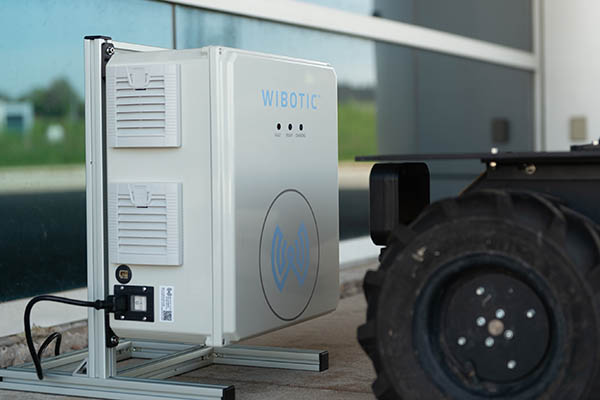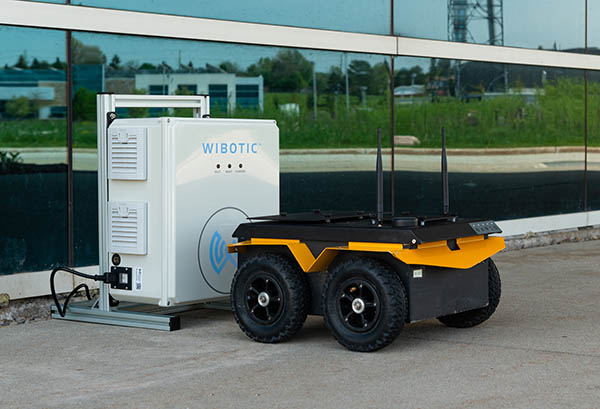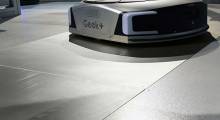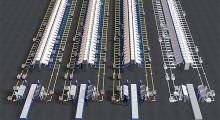WiBotic Inc. and Clearpath Robotics Inc. today announced the availability of wireless charging kits for the Jackal and Husky unmanned ground vehicles. The kits can either be installed on new robots before they are shipped or retrofitted to existing robots with standard tools and simple instructions, the companies said.
“Clearpath has been revolutionizing autonomous robotics for over a decade,” stated Ben Waters, CEO of WiBotic. “Their robots operate across a wide array of rugged environments, from construction sites to oil refineries, to railroad tunnels. With WiBotic technology built into their new wireless charging kits, the Jackal and Husky robots can now operate truly on their own.”
Kitchener, Ontario-based Clearpath Robotics provides robots for research and development, as well as hardware, software, and services to enable self-driving vehicle development, deployment, and operation. The company said it serves more than 500 brands in industries including materials handling, mining, agriculture, military, aerospace, and academia.
How to make UGV charging more reliable
Seattle-based WiBotic provides autonomous charging and energy management systems for the rapidly growing ecosystem of aerial, mobile, marine, and space robotics. The company claimed that its products can help users optimize the uptime of their robot fleets in a variety of industries.
WiBotic said the wireless charging kits “are designed to provide a turnkey solution for wireless power, allowing Clearpath customers to experience fully autonomous battery charging for the first time.” The kits are available through Clearpath's online component store.
A Jackal or Husky unmanned ground vehicle (UGV) can navigate to within several centimeters of a charging station, which can automatically deliver power through the air. This will provide reliable battery charging, even in difficult outdoor environments, according to WiBotic.
Each kit contains a WiBotic charging station featuring a wireless transmitter, housed in a weatherproof enclosure, plus a WiBotic receiver components and mounting brackets specially designed by Clearpath for each robot model.

Kits promise multiple benefits
WiBotic said the wireless charging kits offer Clearpath UGV operators the following benefits:
- Operational cost savings: Jackal and Husky robots can now autonomously charge themselves, which could help customers that use robots in remote environments or those where it is expensive or hazardous for humans to monitor and charge batteries.
- Reliability: In outdoor environments, robots are often exposed to dust, dirt, debris, and moisture. Electrical components subjected to these elements are particularly susceptible to corrosion and mechanical failure, which results in unreliable charging. Fully sealed wireless power kits could increase the reliability of autonomous robots in those environments.
- Programmability: WiBotic chargers provide visibility into a robot’s charging process and can be programmed to deliver the ideal voltage and current for every charge cycle. For instance, it might be good to charge a particular robot’s battery as quickly as possible during working hours to minimize downtime. Overnight, however, it is typically better to charge more slowly for the battery’s long-term health. Jackal and Husky operators can use these customizable controls to optimize uptime while minimizing battery replacement costs.
- Flexibility: Contact-based autonomous docking systems require precise alignment to ensure proper contact of both the positive and negative terminals. Misalignment can result in failed charging attempts, or damage to the dock itself—especially on uneven terrain or in wet, humid, or muddy environments. The new kits offer up to 5cm (1.9 in.) of antenna air gap/misalignment while still delivering full power and efficiency.
- Universality: Different robots use different battery chemistries, voltages, and charging rates. Businesses that operate fleets of robots are frequently burdened with a mix of non-interoperable battery charging stations. The transmitters provided in these kits are universal, so a fleet of diverse robots can share the same charging stations as their Jackal and Husky counterparts.
- Fleet management with WiBotic Commander. Clearpath customers also have the option of using WiBotic Commander to manage networks of charging stations and larger fleets of robots. Commander aggregates historical information on every charge cycle for every robot and provides analytics for optimizing fleet-wide charging processes and battery performance.
“It’s a huge leap forward for operators who want to operate their robots more autonomously and efficiently while also eliminating the potential risks associated with manual battery charging in these often-harsh environments,” said Waters.
“We’re truly excited to partner with WiBotic, a world leader in autonomous charging solutions, to extend the capabilities of our robotic platforms,” said Julian Ware, general manager of Clearpath Robotics. “We had looked for years to find an affordable, rugged, and fit-for-purpose charging solution for our platforms, and in WiBotic, we finally found what we were looking for.”
“The value of a mobile robot in commercial services is proportionate to its uptime,” he added. “With Wibotic wireless charging, our customers are now able to extend the useful runtime of their autonomous robots over the course of a workday without intervention.”
Article topics
Email Sign Up


















